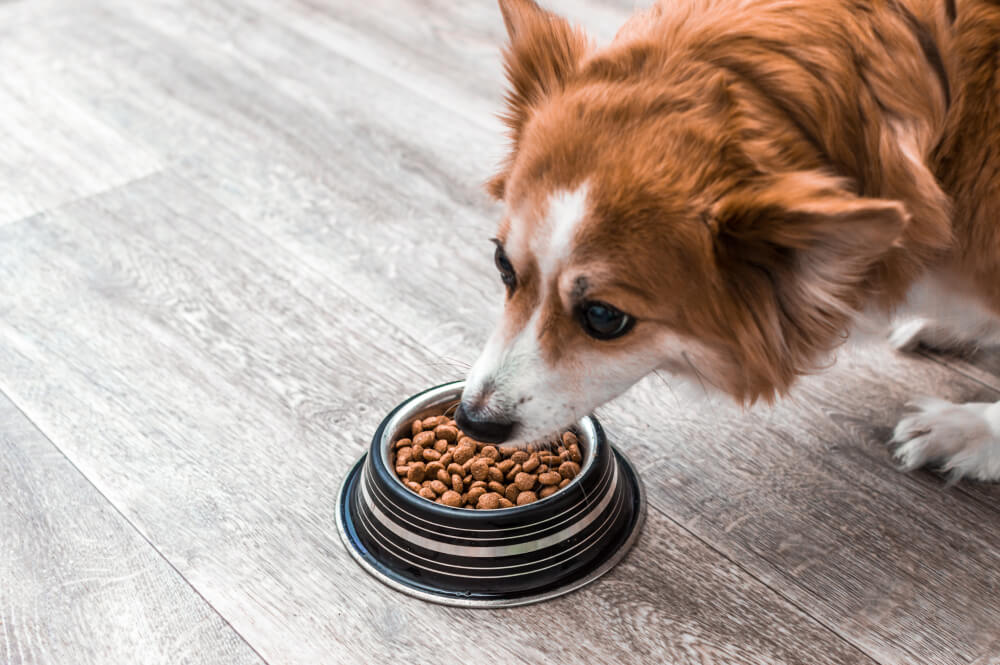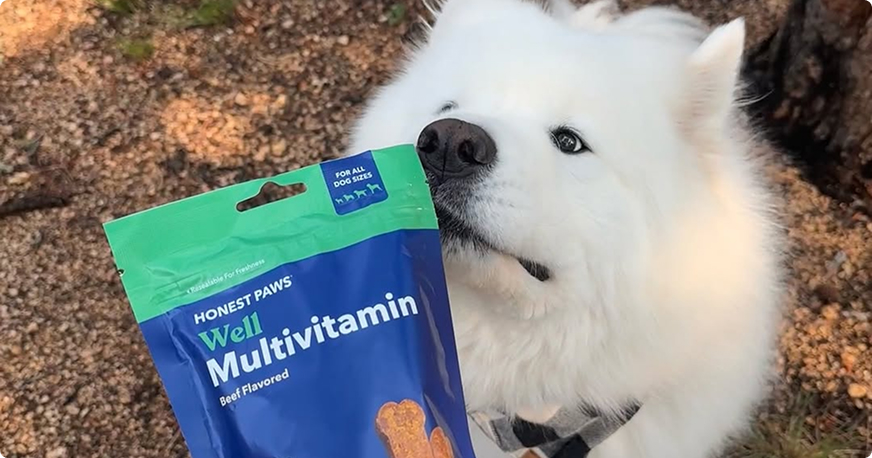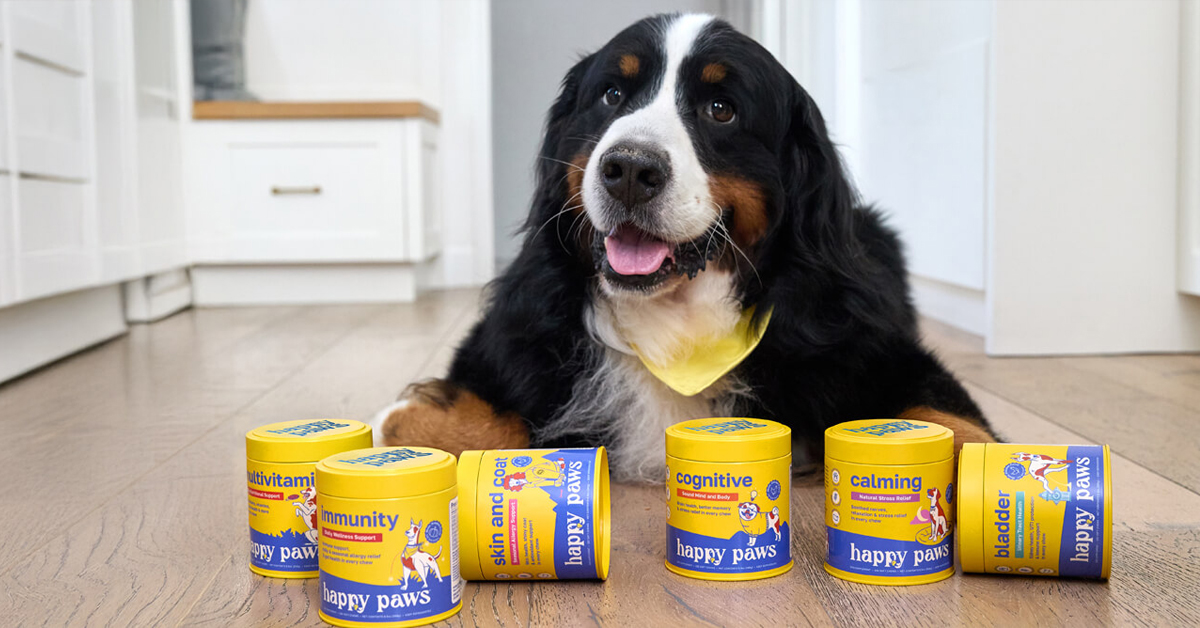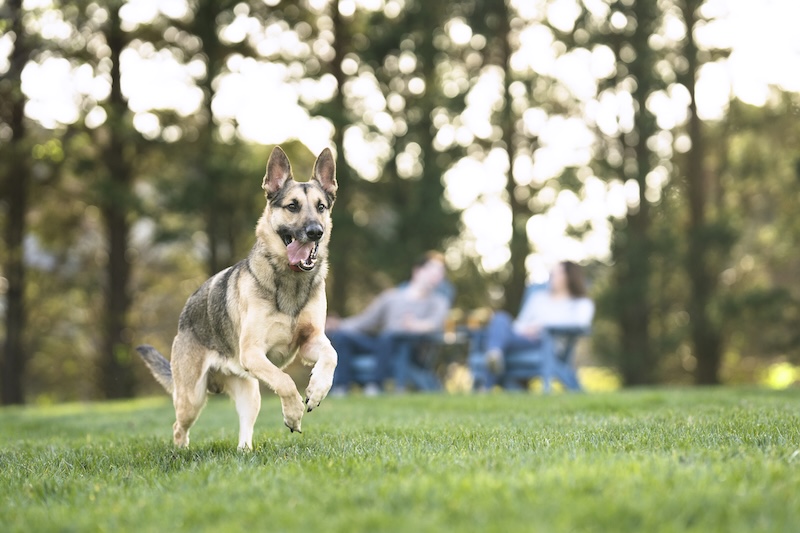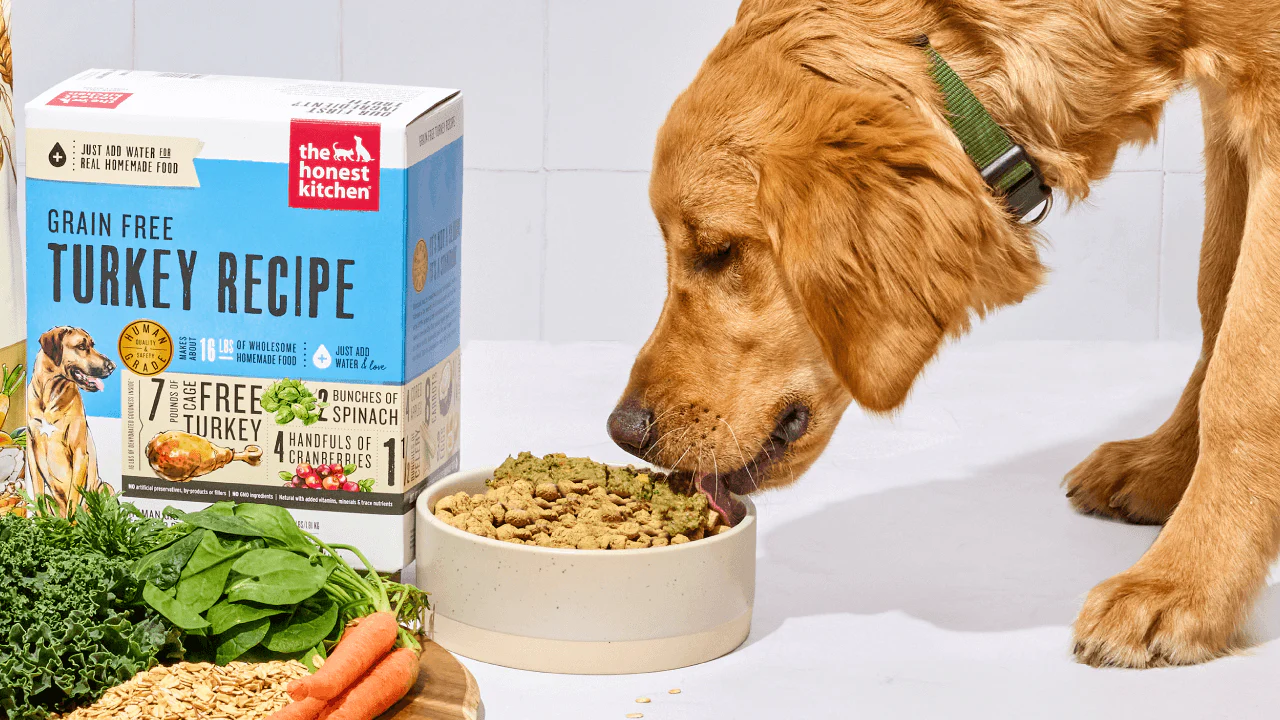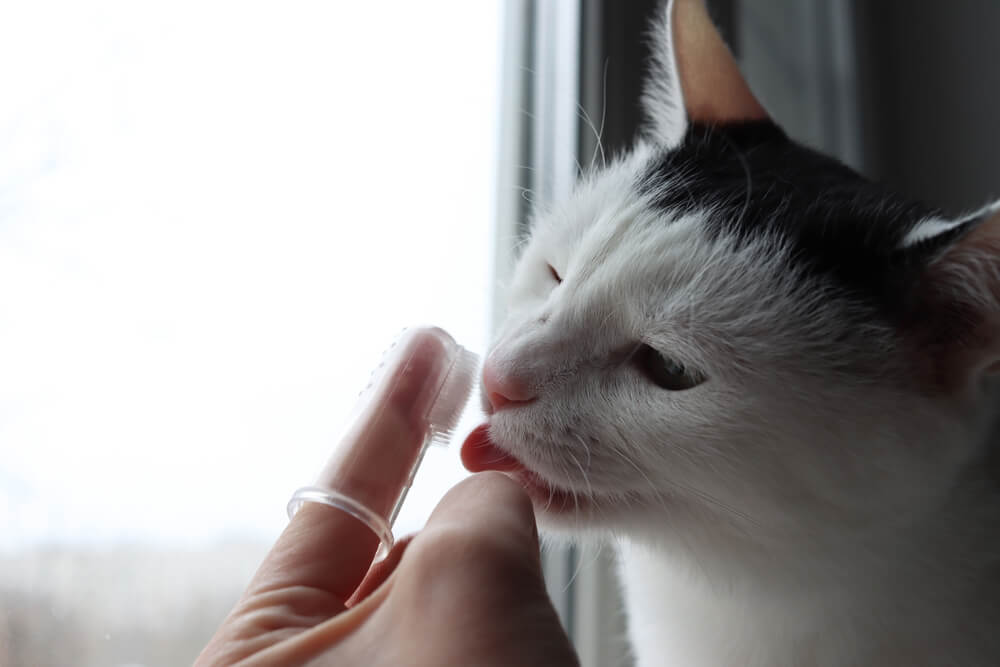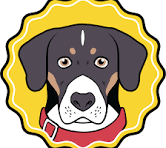How to Cool Down a Dog 8 Different Ways This Summer
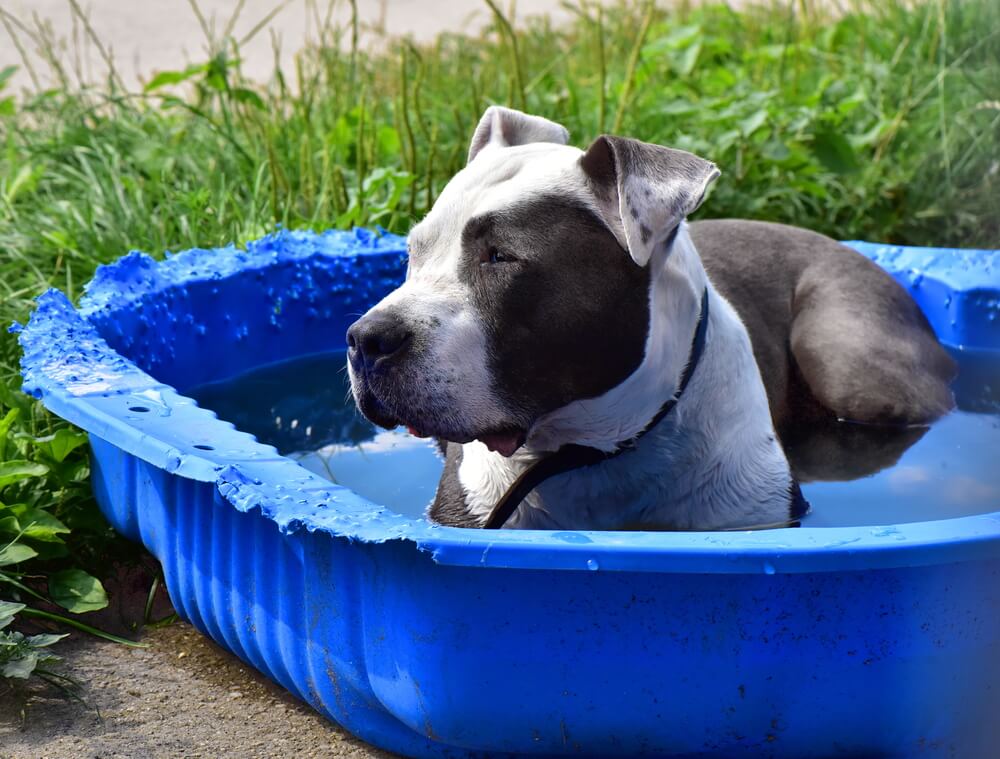

How to Cool Down a Dog 8 Different Ways This Summer
Table of Contents
According to an analysis of five years’ worth of Google Trends data, the search term ‘how to cool down a dog’ traditionally sees significant spikes during the month of July, though searches start to increase as early as May. Such searches have been most popular in states like California, Texas, and Florida, where temperatures can often sit in the nineties and sometimes even approach (or exceed) 100 degrees. Other top states for Google searches on cooling down a dog include Washington, Colorado, Wisconsin, Michigan, Virginia, and Massachusetts.
Pet parents and their fur babies alike enjoy a nice sunny day, but sometimes summer temperatures can reach extreme levels. Just like us humans, high temps can make our pets uncomfortable, agitated, and sometimes aggressive. With heatstroke in dogs being very dangerous and sometimes fatal, it’s important to know why dogs experience heat exhaustion, as well as risk factors and signs your dog might be hot. This article will provide simple and effective methods to keep your dog cool all through the hot summer and also share ways to relieve your pet’s pain as quickly as possible.
What is Heat Exhaustion?
Heat exhaustion happens when your dog is exposed to a hot environment and is unable to cool off enough internally by panting. Heat exhaustion in dogs can happen for a number of reasons like lack of shade. Thankfully, there are a few things pet parents can do to avoid putting their dog in danger when temperatures are high.
Alarming Heat Exhaustion Facts
Heat exhaustion is more common in dogs than expected with hundreds of cases of heat-related illnesses happening every year, some of them being fatal. A recent report listed395 instances of heat stroke and exhaustion in a single year from UK veterinary practices, with 14% of those cases resulting in death.
To comprehend the seriousness of keeping your dog cool on hot days, we’ve compiled some additional alarming facts about heat exhaustion in dogs.
Body Temp Matters
Just two degrees difference in body temperature can be dangerous in dogs. While dogs have a naturally higher body temperature than humans, averaging from101 to 102.5 degrees (Fahrenheit), if your dog’s temp goes above 104 degrees, you need to call your vet immediately. Keep a digital thermometer at home and in your emergency kits so you can check your pooch’s temperature if needed.
Serious Effects
While both are potentially life-threatening, a heat stroke will not cause a stroke in your pet. However, heat stroke can lead to some other really scary things if not treated right away. Serious effects such as dog seizures, brain damage, and coma have been reported.
Why Dogs Experience Heat Exhaustion
From leaving dogs in a poorly ventilated car to not providing enough backyard shade or clean drinking water, most instances of heat exhaustion are preventable. Be aware of why some dogs experience heat exhaustion so that you can keep your own dog healthy and happy.
Hot Environment
If you’ve ever been to an outdoor summertime event like a backyard BBQ or a baseball game, you know how hot it can start to feel right under the sun. Just like us, dogs need shade to cool down.
It’s also critical to know to never leave your dog in a car alone. Even if it’s a cool day, even if the air’s on, and even if it’s just for a short time— don’t do it.
While a sunny day in the 70s sounds perfectly pleasant, a Stanford study showed that in just an hour, a car’s temperature rose to 116 degrees internally when left out in 72-degree heat.
Keep your animals safe by never leaving them unattended in the car and always providing shade when out in the sunshine.
Not Drinking Enough Water
You may be curious how much water a dog needs each day. Generally, for every pound of body weight, your dog needs 1 ounce of water (1/8 of a cup) each day.
For example, if you have a 65-pound pup, you can assume they’ll need about 65 ounces, or just over a half of a gallon of water a day. And this may be higher on hot days!
Be sure to wash water bowls daily and provide clean and cool water to your pups on a daily basis to keep them healthy and hydrated.
Overworked
While you’re out on a walk with your dog, be cognizant of the pace and don’t force your fur baby to run if they seem tired.
If the temperatures are high, both you and your dog can easily get exhausted and dehydrated with too much running and not enough shade or water when out and about on a hot day.
Even if you’ve done the same run or other workout together a hundred times before with ease, if it’s especially hot out, it could be potentially dangerous for your pup. Be aware of warning signs your dog may be showing like excessive panting and always be near shade and fresh water to stay safe.
Risk Factors
As mentioned earlier, all dogs can potentially suffer from heat stroke and heat exhaustion. Here are four risk factors to be aware of:
Hot Vehicles
Because so many people take their dogs on road trips and drives, they tend to leave them unattended in the car for a while. Like mentioned before, even with the windows down, the interior of a car can reach incredibly high temperatures in a very short time, so never leave your dog in a car unattended.
Lack of Shade
When out in the open with your doggo on a hot afternoon, you should always walk in paths that have sufficient shade or cover from trees.
Having insufficient shade leads to increased body temperatures. Keep your dog cool by always making sure some solid shade is nearby when the sun’s out.
Dog Type
Because of the differences in physical appearance and characteristics, certain dog breeds are more prone to heat-related exhaustion and heat stroke than others.
Flat-faced dogs with short snouts such as Pekingese, Bulls, and Pugs need extra care and attention during the heat of summer.
Dogs with thick furs such as Huskies, Pomeranian, Great Pyrenees, Chow Chows, and German Shepherds are susceptible to heat exhaustion because of the insulation provided by their thick coats. Hence, they get hot quickly and cool down slowly.
Because size really does matter when it comes to heat dissipation, giant dogs find it a lot more difficult to keep themselves cool.
Older dogs are also more sensitive to temperature changes than younger dogs and may overheat easily.
Overweight dogs that pack pounds of fat underneath the skin also find it difficult to dissipate excess heat from their bodies. In an extremely hot environment, you have all the ingredients necessary for full-scale heat exhaustion.
Dr.Emily Hall reminds us, “All dogs will benefit from maintaining a healthy body weight, but if your dog is at particular risk [of heat illness], then preventing obesity could be lifesaving.”
9 Signs of Heat Exhaustion in Dogs
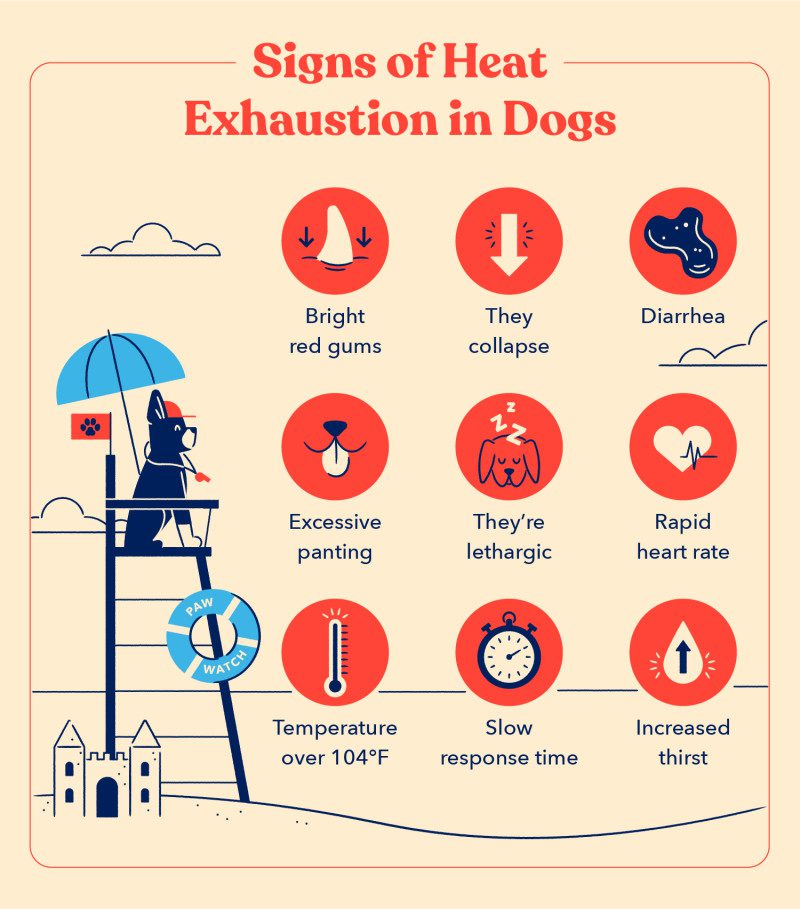
Now that you know what heat exhaustion is and what causes it, how can you tell if a dog is overheated?
Veterinary Oncologist, Dr. Cristina Vulpet tells us, “There are a series of symptoms that are less discernible than [others]” and urges pet parents to look out for very early stages of heat exhaustion, such as reduced response to commands or voice.
Here are some additional ways to identify heat exhaustion in dogs.
- Bright Red Gums: Bright red gums are signs of increased blood flow to the mouth, the primary cooling center for dogs. If your fur baby’s gums are very red or bright pink during the hot summer day, it’s an easy sign to spot that he may be overheated.
- Collapse:If your dog has lost balance or consciousness and has collapsed, head to your vet immediately. The American Kennel Club Canine Health Foundation suggests wetting your dog with a cool cloth and calling your vet ahead of time so they can prepare for your arrival.
- Diarrhea: Diarrhea is another tell-tale sign of heat exhaustion. A dog’s upset stomach sometimes accompanies collapse, and it is characterized by abnormally soft stool or stool that contains small amounts of blood.
- Excessive Panting: Since dogs lose excess body heat and regulate their temperature by panting, a dog suffering from heat exhaustion will show rapid breathing and excessive panting.
- Lethargy:If you notice your dog’s looking lethargic and tired on a hot summer afternoon, then you have every reason to be worried. An overheated dog will nap more than normal and look like it’s carrying a thousand pounds of weight when standing up or walking.
- Rapid Heart Rate:When you notice a rapid rise in your dog’s heart rate, it’s not a sign that Fido’s in love. In fact, if you notice excessive panting or dizziness in your dog, it may be an indication of an increased heart rate from heat exhaustion. An increased heart rate is the heart’s effort to regulate internal temps, so act quickly if you notice any worrisome changes.
- Slow Response Time:Another commonly overlooked sign of heat exhaustion in dogs is a slow response time. If your dog is typically alert, if he slowly stops responding to his name or simple verbal commands during the hot summer afternoon, then there’s a likelihood that the heat could be affecting his attentiveness.
- Temperature Over 104 Degrees:If your dog’s body temperature reaches a staggering104 or more, then you have every reason to be alarmed. It’s time to take your furry friend to the vet ASAP.
- Increased Thirst:Most animals will be thirstier and drink more water than usual when the blistering heat of the summer months strikes. That’s why your dog must always have access to fresh, clean, cool water for drinking.
If your dog is showing any of these signs of exhaustion, take immediate action to cool them down.
8 Ways to Cool Down a Dog Safely
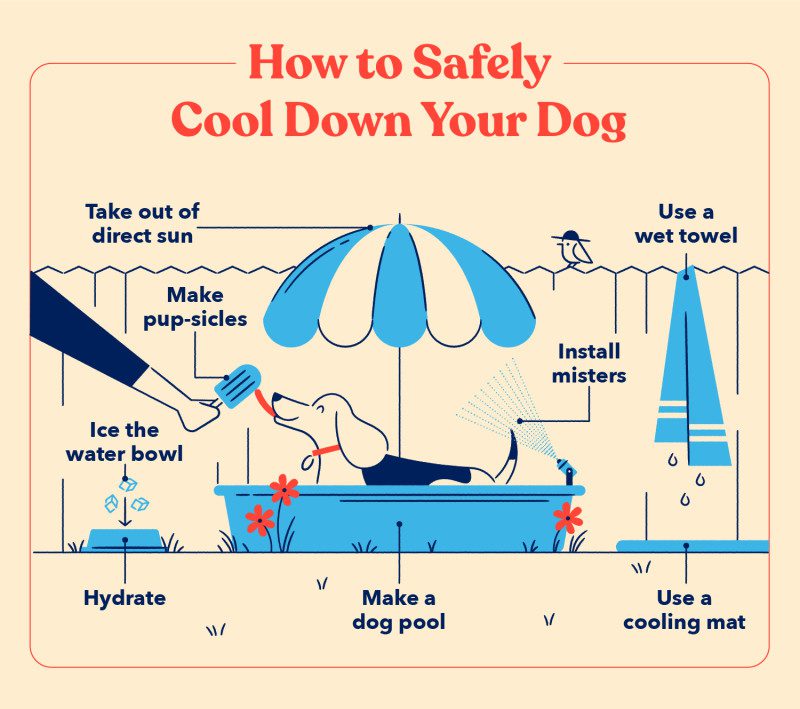
K. Williams, BSc, DVM, CCRP and E. Ward, DVMremind us that luckily, “If the body temperature did not become extremely high, most healthy pets will recover quickly if they are treated immediately.”
So what are the most effective ways to cool down a dog this summer? Here’s how in eight easy ways.
- Create a Cool Space:One simple way to cool down your overheating dog is by creating a safe space for him to relax and cool off from the blistering heat. If you’re indoors, get a fan or an air conditioner to lower environmental temperatures. If you’re outside, find a nice, safe shade for Fido to cool off and relax.
- Hydrate:Just like for us, cold drinking water has an immediate cooling effect and is a fast and easy way to avoid heat exhaustion. Keep clean, cooled water on hand whenever you and your pooch are out in the heat.
- Use a Wet Towel:Does putting a wet towel on a dog really cool them down? Yes, if done properly with a nice cool drenched towel. However, you have to be careful not to spray water that’s too cold directly on your dog. You don’t want to shock or surprise them.
- Install Misters:Instead of using a garden hose, misters are specially designed devices attached to the water supply and spray a very fine mist of cool water. It’s friendlier to use a mister on your dog than shooting large amounts of water on him with a garden hose.
- Make a Dog Pool:People love taking a dip in the pool every now and then, so why not our canine buddies? Making a dog pool is another effective way to cool down your dog, but it must be done with caution. If your dog is almost at the brink of heat stroke, it’s more effective to slowly lower his temperature than throwing him in a pool.
- Ice Their Water Bowl:There’s nothing a little ice-cold drink can’t fix. Adding a few ice cubes to Fido’s water bowl will ensure he has a constant supply of cool drinking water when the summer heat comes.
- Make Pup-sicles:Who would say no to a tasty frozen treat on a hot summer day? Serve your dog some frozen, tasty pup-sicles and watch how fast his tail wags. The best part of all, it is super simple to make right in the comfort of your home.
- Purchase a Cooling Mat: Dog cooling mats are specially designed mats that help to keep your dog cool during hot weather conditions. These mats come with a unique cooling gel that absorbs heat and remains cool and comfortable for your dogs to lie on. You also won’t need to spend extra money on electricity to keep your dog cool and happy. Win-win!
Unsafe Ways to Cool Down Your Dog
While the above techniques are some simple and safe ways to cool down your dog this summer, be aware of unsafe ways as well.
Below are some of these techniques and why you should steer clear of them.
1. Alone in a Car with AC.
While air conditioning is a good idea for cooling down a hot dog, leaving your dog alone in a car even with the air-conditioning on is still largely inappropriate, and the temperature changes are too unpredictable. If you see an animal alone in a parked car, you can notify local authorities or animal control if the owner doesn’t return within a few minutes.
2. Ice Bath.
Ice baths may be good for sports athletes but not advisable for use on your dogs. This is because they cause drastic temperature changes, which is unhealthy for a dog suffering from heat exhaustion.
3. Ice Pack.
Ice packs are another way people cool down their hot dogs, but this method is unsafe and unhealthy. Dogs may accidentally ingest the substance in ice packs, which can cause stomach problems.
4. Shave Bald.
Shaving off all the hair on your dog may seem like a shortcut method to cooling down your dog, but it exposes your dog to a whole different level of environmental threats. While it’s okay to shave spots for medical reasons like surgery or hot spots on dogs, the coat is there for a wide variety of reasons and should not be shaved off completely.
5. Swim in Dirty Water.
Dirty water might do the trick and keep your pet cool, but the water is home to millions of disease-causing organisms that are looking for a suitable host to infect. Protect your pooch from the dangers of dirty water and keep them at home in the pool or a known safe natural water source.
5 Safe Indoor Exercises for Hot Days
With all this talk about heat exhaustion and heat stroke in dogs, is it still safe to exercise your dogin the heat of the summer months?
Yes, it is. However, if the temperature is too hot out, consider sticking to safe indoor exercises only. Below are some of the most exciting indoor exercises to try out on hot days with your dog.
1. Doga
Since your dog can’t go around running in the blistering heat, you can adopt dog yoga AKA doga. While this may sound weird, dog yoga is a thing and it’s gradually becoming a trend. Doga encourages relaxation, provides mental stimulation, and offers bonding opportunities. Om!
2. Indoor Training Sports
There are various fun indoor sports and games to play with your dog to keep him entertained. These exercises help to keep your dog mentally and physically stimulated while keeping him safe, and they include: playing hide and seek, indoor swimming, playing with stuffed animals, practicing high jumps, wrestling or playing tug-of-war, setting up an obstacle course, etc.
3. Play A Game of “Find It” With Treats
This is another way to tire your dog while having fun. You can hide certain objects or toys around the house and ask your dog to find them, rewarding him with treats when he does.
4. Interactive Dog Toys
Because dogs need enough mental and physical stimulation to fight boredom indoors, interactive dog toys do come in handy, and they do a pretty good job of exercising your dog while indoors. Some of these interactive toys include Kibble-Dispensing Push Toys, Treat-Dispensing Puzzle Toys, Hide-And-Seek Toys, Responsive Toys, and High-Tech Toys.
5. Work On Reinforcing New Behavior
When it’s too hot to exercise outside, that’s an opportunity to work on training your dog and teaching him new tricks and behaviors.
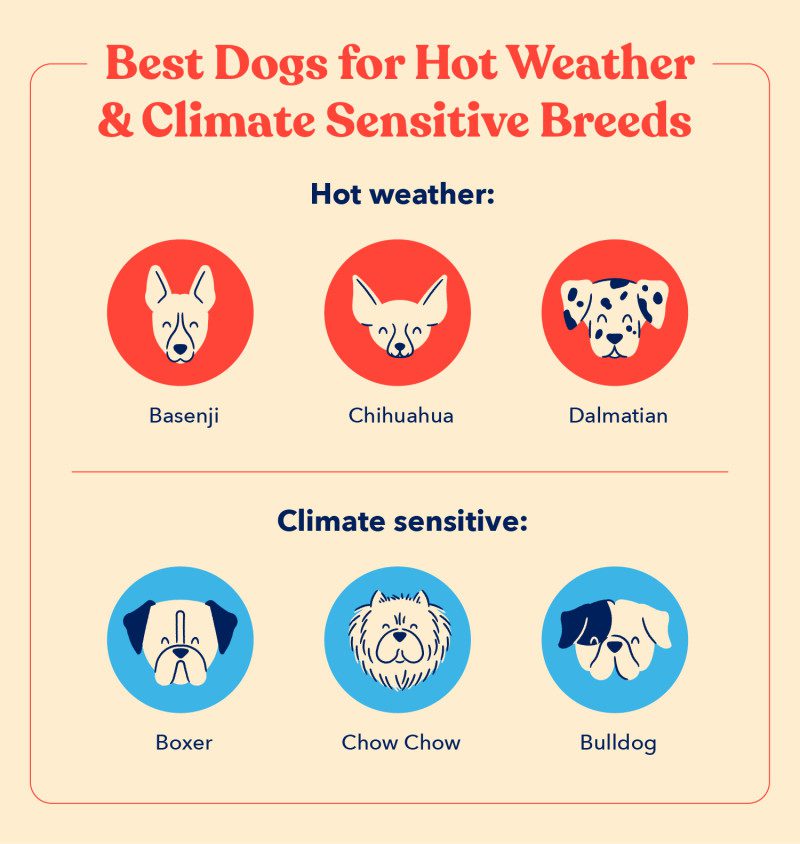
Best Dogs for Hot Weather
If you live in a country or city with summer temperatures that reach extremely high levels, you might want to get a dog that’s best suited for this type of temperature.
Some of these highly adaptable breeds include:
- Basenji
- Chihuahua
- Dalmatian
- Doberman Pinscher
- German Shorthaired Pointer
- Great Dane
Climate Sensitive Breeds
Unlike their heat-resistant colleagues, these dogs don’t do well in extremely hot weather, mostly due to their physical characteristics. Some of these breeds include:
- Boxer
- Chow Chow
- English Bulldog
- French Bulldog
- Pug
- Shih Tzu
More Hot Weather Safety Tips
Take Morning / Evening Walks
During the heat of summer, taking outdoor walks with your dog in the afternoon should be discouraged. It’s preferable to go for early morning walks or hikes with your dog because the environment is still cool and comfortable for you both.
Keep to Shady Areas
Trees provide ample protection from the scorching summer sun. So if you must walk your dog in the afternoon, it’s important to always plan your walks in places with enough shade and natural paths.
Short and Sweet Walks
Instead of pushing your limit with one long, exhausting walk, why not break it down to two or three short walks scheduled throughout the day.
Keep the Paws in Mind
A dog’s paws are extra-sensitive to temperature changes and are important for regulating temperature. So when you set out on a walk with your dog, always remember to avoid pavements and surfaces that are too hot or too cold. A simple way to judge the heat of the ground: feel it with the back of your hand. If you can’t leave it there for seven seconds, the pavement’s likely too hot for paws.
A Paddling Pool for Paws
If going for a full-body dip in a pool is impossible, a shallow paddling pool filled with cool water makes for a great alternative. It doesn’t have to be a special dog pool, either. A plastic kiddie pool will work great to provide a good way to cool down your dog.
Final Thoughts
There you have it, the ultimate guide every dog owner needs to know on how to cool down a dog this hot dog summer. Remember that whenever the weather is too hot and uncomfortable for you, it certainly is hot and uncomfortable for your furry friends.
Be sure to adopt some of these cooling techniques to provide relief for pets living in hot regions during the summer months.
As we celebrate summer, remember this quote from Josh Billings, “A dog is the only thing on earth that loves you more than he loves himself.” We owe it to them to keep them healthy and happy all through their lives.
